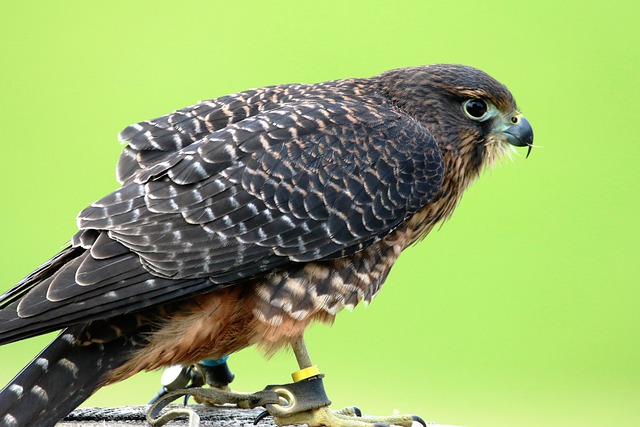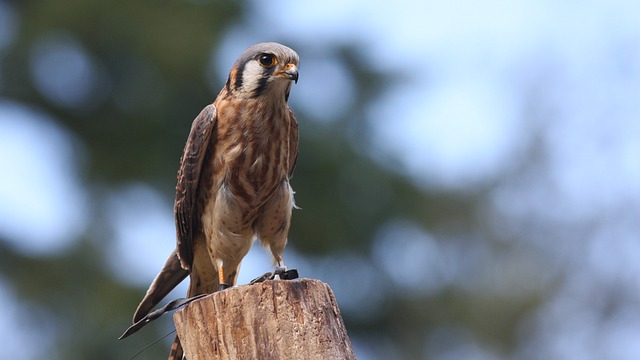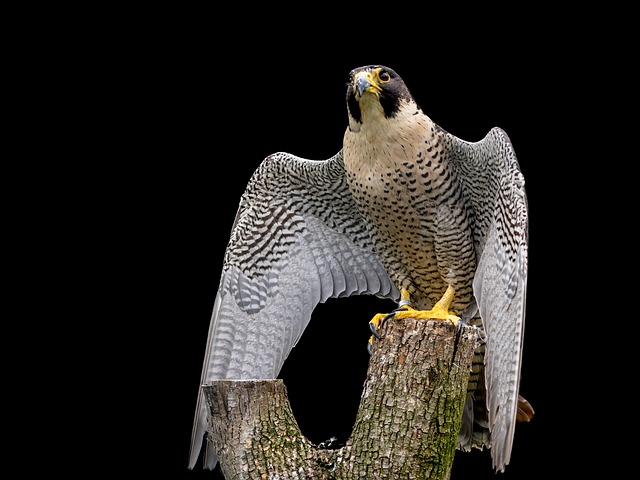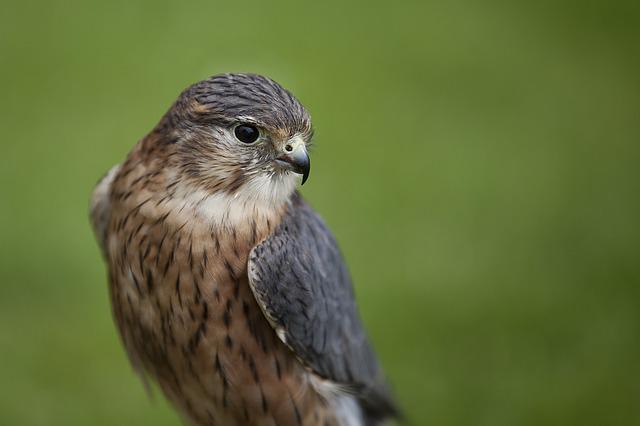From the majestic Peregrine Falcon soaring high above the city to the elusive Aplomado Falcon hiding in the brush, Texas is home to a diverse array of falcon species.
But do you know which types of falcons call the Lone Star State their home?
In this article, we’ll take a closer look at the five different species of falcons found in Texas and the unique characteristics that make them stand out.
| Image | Name |
|---|---|
 | Aplomado Falcon |
 | Prairie Falcon |
 | American Kestrel |
 | Peregrine Falcon |
 | Merlin |
Types of Falcons in Texas
1. Aplomado Falcon

The Aplomado Falcon is among the most beautiful falcon having white and black bands on their face and medium size, long tail, and long wings.
Tricolored markings may be seen on the underside: a white to the buffy chest, strong black chest streaks, and a rusty lower abdomen.
Its back is blue or dark brown, and its tail is white and black.
The underside of the wings has a dark color with heavy bars.
The kek is the sound made by this species.
The Aplomado Falcon prefers to set up its nest in grassy or wooded regions that are adjacent to a body of water.
Birds of prey like magpies, ravens, crows, kestrels, and jays sometimes reuse the stick nests of other birds of prey.
They have been known to force other birds out of their nests in an aggressive attempt to take over the territory.
Typically, the nest is located in a tree or shrub of the genus Yucca. Nesting sites include the ground and the crossbeams of power poles.
These birds do not construct their own nests.
Females of this species typically produce a clutch of 2 to 4 eggs.
The brown-spotted white eggs need to be incubated for 30 to 33 days.
Hatchlings need between 29 and 36 days to reach maturity and take their first flight after hatching.
The Aplomado Falcon’s diet consists of a variety of birds, rodents, insects, and lizards.
Prior to its extinction in the 1930s, the Aplomado Falcon was a frequent sight in the arid grasslands of Arizona, Texas, and New Mexico in the southwestern United States.
In the 1980s, the population across southern Texas began to recover thanks to the release of 1,500 captive-bred animals.
It’s currently critically endangered and its sole known distribution is the southern part of Texas.
In the remainder of their range, they are quite rare.
It is believed that there are 200,000 breeding adults around the globe, with just 100 residing in the state of Texas.
Pesticides, overgrazing, prairie dog, and agriculture habitat loss extermination programs are all bad news for the Aplomado Falcon.
Both the Trans-Pecos area in the extreme west and the southeast of Texas are permanent homes for Aplomado Falcons.
Its natural habitats are deserts and grasslands with a smattering of Yucca and Mesquite trees.
Savannas, pastures, marshes, forest borders, and grasslands with a sprinkling of palms make up the remainder of its southern habitat.
Bentsen-Rio Grande Valley State Park, Aransas National Wildlife Refuge, Mustang Island State Park, and Laguna Atascosa National Wildlife Refuge are excellent places to see this species.
2. Prairie Falcon

The Prairie Falcon is a falcon that is between medium and big in size and has long wings and a long tail.
Both males and females have brownish markings on their bellies and chests, while their underparts are white.
Their upper bodies are brown, and their underparts are white.
There is a thin line located over the eye, and there is a mustache that is brown in color on the face.
A black area can be seen on the underwing between the “wrist” and the “armpit.”
The kiik-kiik-kiik sound is the usual call that is produced by this bird.
The Prairie Falcon prefers to set up its nest in open locations, particularly on cliffs and bluffs.
The nest is little more than a basic depression that was constructed using the various pieces of trash that could be discovered at the nesting location.
This species will sometimes make use of eagle or corvid nests built of sticks that have been abandoned.
In most cases, the nest may be found in a crack, in a crevice, on the edge of a cliff ledge, or concealed behind an overhanging on the side of a bluff.
There are times when the nest is built above buildings, tunnels, trees, or even the towers of power lines.
Depending on the time of year, the female will lay anywhere from 2 to 6 eggs in each clutch.
The eggs have a cream or rusty brown color with brown spots on them.
Between 29 and 39 days are spent incubating the eggs.
The young birds remain in the nest for an extra 28 to 40 days of growth after they have hatched before they get up the nerve to try to fly.
Birds of prey, small animals, and insects make up the majority of a prairie falcon’s diet.
Doves, meadowlarks, larks, and shorebirds are all examples of birds that might be considered prey for pikas, whereas ground pikas and squirrels are examples of mammalian prey.
It is estimated that there are 80,500 breeding birds in the Prairie Falcon population, and this number looks to be constant.
The Prairie Falcon is a species that is quite numerous and widespread.
This species is in danger owing to the use of pesticides such as illegal hunting, DDT, and the destruction of its natural habitat as a result of things like land conversion and human disturbance, and mining operations.
The western half of Texas, and the Texas Panhandle, in particular, is the most common location to see a prairie falcon.
They are more likely to be spotted during the winter months; however, they might be seen at any time of the year.
They may be found in a wide variety of environments, such as agricultural land, shrubland, grassland, desert shrubsteppe, and alpine tundra.
These falcons can be spotted in a variety of locations, but the Aransas National Wildlife Refuge, the Santa Ana National Wildlife Refuge, the Buffalo Lake National Wildlife Refuge, and Big Bend National Park are four places in particular that are well worth traveling to in order to get a good look at them.
3. American Kestrel

The American Kestrel is a tiny falcon with strong wings and a long tail. It is native to North America.
The wings of the male are slate blue, while the male’s back is rusty with black bars.
The color of the bottom ranges from white to reddish brown.
The body of the female is rusty all over, and she has black striping on the top half of her body.
Both the male and female have a grey head and two black stripes on their mustache-like markings.
The underwings have a striped pattern of white and black.
This species’ signature call consists of a string of notes that may be described as sounding like kiilly or kleee.
The American Kestrel prefers open or mostly open locations to nest in.
These kestrels do not construct their own nests; rather, they use pre-existing woodpecker holes, nest boxes, rock crevices, naturally occurring tree holes, and even the corners of buildings as places to roost and raise their young.
The majority of the time, nesting places for this species are found in trees that are either positioned on the border of a forest or in open areas.
The nest is formed out of extremely basic materials and consists of a shallow depression that is carved out of the hole using whatever debris is still there.
In each clutch, the female hatches between four and five eggs.
During the course of a season, a yellowish-white or brownish-red egg having grey or brown markings may be deposited, and the bird may lay up to two clutches.
The duration of the incubation phase is between 26 and 32 days. The hatchlings continue to develop for another 29 to 30 days after they’ve emerged from their eggs.
The American Kestrel consumes a diet consisting mostly of insects and other invertebrates, such as butterflies, beetles, cicadas, spiders, moths, scorpions, and grasshoppers.
In addition to this, they consume other animals, such as snakes, songbirds, frogs, lizards, and small mammals, including voles, mice, bats, and shrews, for food.
The population of American Kestrels is big and broad, and it is estimated that there are 9.3 million breeding birds.
Despite this, there has been a decline of 53 % in the size of the population over the course of the last 5 decades.
The elimination of potential nesting areas by cutting down trees and clearing land poses a hazard to the species.
The need for “clean agriculture” has resulted in the clearance of thick vegetation, which has led to a reduction in the amount of available prey.
Pesticides destroy or infect a large number of potential prey items, which poses a danger to the American Kestrel in a roundabout way.
The American Kestrel is a migratory species, and the fall, winter, and early spring are the times of the year when there are most of these birds.
It is among the most frequent falcons across north Texas because it stays there throughout the year, although the majority of falcons move to higher latitudes in the summer so they can reproduce.
This species inhabits open environments that have few trees and a sparse understory, such as deserts, meadows, parks, suburban areas, grasslands, urban areas, and agricultural land.
This species has a large range and could be viewed in a variety of settings; however, Big Bend National Park, the Aransas National Wildlife Refuge, Brazos Bend State Park, and Goose Island State Park are four places that are particularly recommended for observation.
4. Peregrine Falcon

The Peregrine Falcon is a huge species of falcon that is characterized by having long wings and a long tail.
The underparts of this species are white, and it has black bands running horizontally across the chest.
The head is black, and there is a big mustache on the front of the dark face.
The top side is blue-grey.
White with black patterns may be seen on the underside of the wing.
This species has a very loud and quick kaak-kaak-kaak that it uses as its call.
Nesting habitats for peregrine falcons often include cliffs or regions with towering structures that are surrounded by plenty of open space.
Nests are often built on ledges of cliffs, although they have also been known to be placed on silos, bridges, towers, and other man-made structures.
This species may sometimes use the abandoned stick nests of other birds of prey, such as corvids, cormorants, or other types of raptors.
On the ledge, their nest is often little more than a shallow hole dug into the sand or another substrate.
In a single season, the female will typically lay anywhere from two to five eggs in the nest in the form of one clutch.
The eggs range in color from beige to a brownish hue and have spots or blotches of brown, purple, or red on them.
The duration of the incubation phase ranges from 29 to 32 days.
After hatching, the chicks need between 35 and 42 days of development time before they are ready to fly.
The diet of the Peregrine Falcon consists nearly entirely of different types of birds; researchers have identified approximately 2,000 different bird species as potential prey items, with over 455 of those species living across North America.
Pigeons, starlings, gulls, ducks, jays, and thrushes are some of the more common species that these predators target as prey; nevertheless, they have been observed to prey on birds as huge as cranes and as little as hummingbirds.
They also regularly target bats as a source of food.
The population of peregrine falcons is now growing and is on the road to recovery after experiencing a steep decline in the middle of the 20th century.
These birds may be found all over the world.
There are around 330,000 breeding individuals in the world’s population, according to estimates.
This falcon species is in danger due to the deterioration of its natural habitat, the interference of humans, illegal hunting, the use of poisons, and the theft of eggs.
The Peregrine Falcon may be found across the state; however, during the winter months, the biggest concentrations of these birds occur near the shore.
After migrating south, they often only show up in the wintertime in the northern part of the state.
They can be discovered in most open habitats like shrubland, grassland, mudflats, and coasts, but they can also be found in hilly places, along rivers, in valleys, on lake borders, and in urban contexts such as cities.
They are seen mostly in open habitats.
Within the boundaries of the state are breeding populations that are permanent residents.
Aransas National Wildlife Refuge, Big Bend National Park, the University of Texas Tower, and Santa Elena Canyon are all places where you may observe them.
5. Merlin

The Merlin is a tiny bird of prey that is characterized by having long wings and a tail.
The uppersides of the males are typically grey, and they have a light mustache and a tiny line over each eye.
The color of the body might change depending on where in the world you are, and some subspecies do not possess a mustache at all.
The underside has a spotting pattern, and the underwings are a dark color.
The underparts of the females are extensively marked with streaks, and they have a narrow line that runs just over their eyes.
The sound that is created by the Merlin is described as having a high pitch.
The Merlin prefers to nest in semi-open to open habitats with trees and bushes that are either coniferous or deciduous, and these regions are often located near water.
Infrequently, they will reproduce inside the confines of urban forests.
They don’t construct their own nests; rather, they make use of abandoned stick nests made by magpies, ravens, hawks, and crows.
Nesting locations may include cliff edges, tree holes, or the ground, although this occurs only very seldom.
The nest is made out of extremely basic materials and consists of a hollow in the substrate or detritus of the nesting place.
The female produces anywhere from 4 to 5 eggs in a single clutch, and she only lays one clutch throughout the course of an entire season.
The eggs have a chestnut color pattern on a brown background.
The eggs have a gestation period that ranges from 29 to 33 days.
After the eggs have been fertilized and the chicks have hatched, they will spend the next 26 to 31 days mature.
The food of the Merlin is mostly composed of other birds. Sparrows, sandpipers, waxwings, larks, and a plethora of other shorebirds are some examples of things that fall under the category of prey.
Dragonflies and bats may also be victims of predation in certain circumstances.
In the last 5 decades, the population of the Merlin has increased at a rate that is near to 2% more than it was each year.
It is predicted that there are 3.21 million mating individuals belonging to this widespread species.
They have profited from human civilization, which has resulted in a rise in the number of house sparrows (Passer domesticus), which the Merlin relies on as a source of food.
The presence of a large number of crow nests in urban settings has also contributed to the enhanced availability of nest sites for the Merlin.
Human interference at nesting locations, illegal hunting, egg harvesting, habitat damage, and the use of pesticides are all potential threats to this species.
The Merlin is a very frequent migratory bird that travels to Texas during the winter months.
It may be seen in Texas near the coast most of the time.
They are seldom seen throughout the summer since they spend that time of year breeding farther north.
They are found in open deciduous forests, grasslands, coastal habitats, scattered woods near water sources, urban and suburban areas, and grasslands with deciduous trees.
They are discovered all across the state, but among the best places to look for them are the Hagerman National Wildlife Refuge, the Bentsen-Rio Grande Valley State Park, South Padre Island, and the Aransas National Wildlife Refuge.
Conclusion
The state of Texas is home to a staggering amount of bird species and is widely regarded as a premier destination for birdwatchers around the country.
If you like birdwatching, Texas is one of the greatest places to visit in the USA.
Thanks to its proximity to Mexico, rare avian species from Central and South America may find their way to the United States.
This is especially the case for species like the Bat Falcon and the Collared Forest-falcon, which have reached their northernmost range limits in Mexico yet have been seen crossing into the United States through Texas.
During the winter, when the falcons fly south from their nesting grounds to warmer places with a larger availability of food, Texans have the highest chance of seeing a falcon.
The ideal time to see falcons is from November to March, and you’ll find the greatest diversity of them along the shore.
The five real falcons of Texas are a sight to see, what with their lightning-fast speeds, impressive hunting prowess, and keen vision.
Every birdwatcher visiting the state should make a point to keep an eye out for falcons since there are few regions that aren’t home to at least one species.
FAQ
Can you name the state's biggest falcon?
Caracaras are the longest of the Texan falcons, growing to over two feet in length at maturity. The length of the wingspan is likewise remarkable, measuring in at a full four feet.
Can you name the state of Texas' biggest avian?
Whooping cranes, the largest flying bird in North America, stand at about 5 feet (1.5 meters) in height. In terms of size, their wingspan is around 7.51 feet (2.33 meters).
Exactly how does a falcon in Texas appear?
Prairie Falcons have a brown back and a white chest and belly with brown spots. As seen below, the area beneath the wing (the “armpit”) and the wrist are both completely black. If you look at it from above, you can see that the tail is lighter in color than the back and the wings. They have a brown mustache stripe and a white stripe over each eye.
Last Updated on March 22, 2023 by Lily Aldrin
